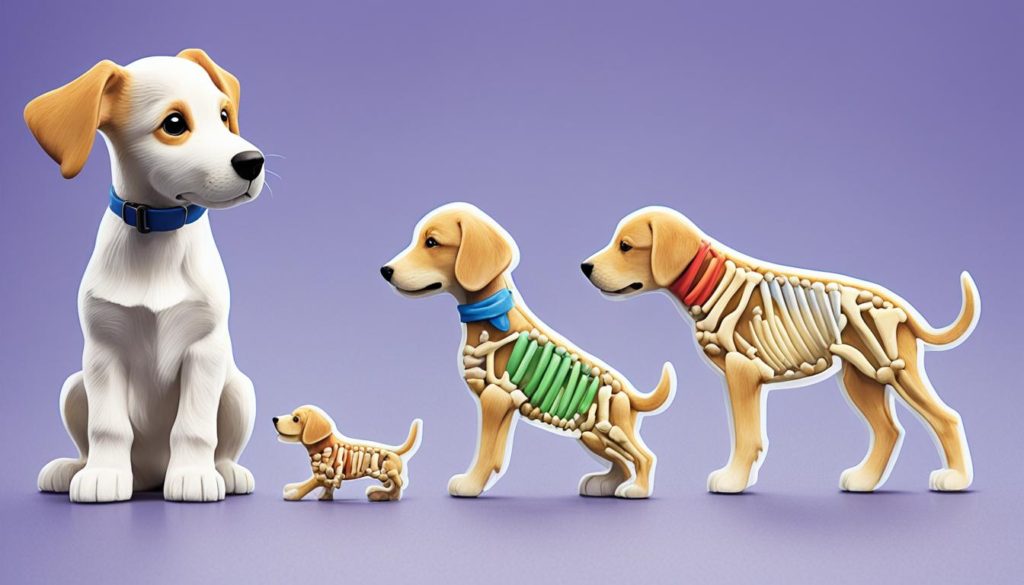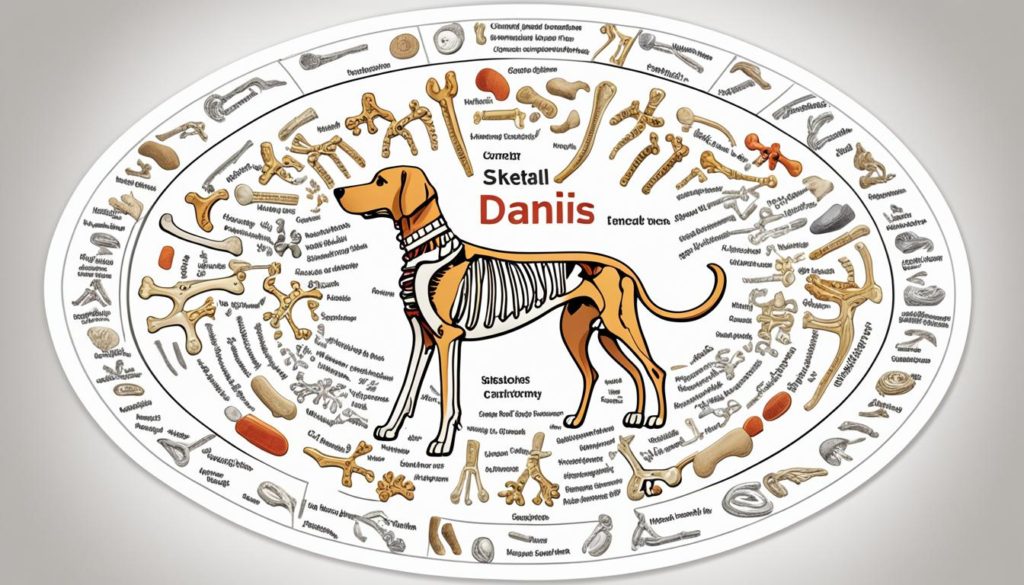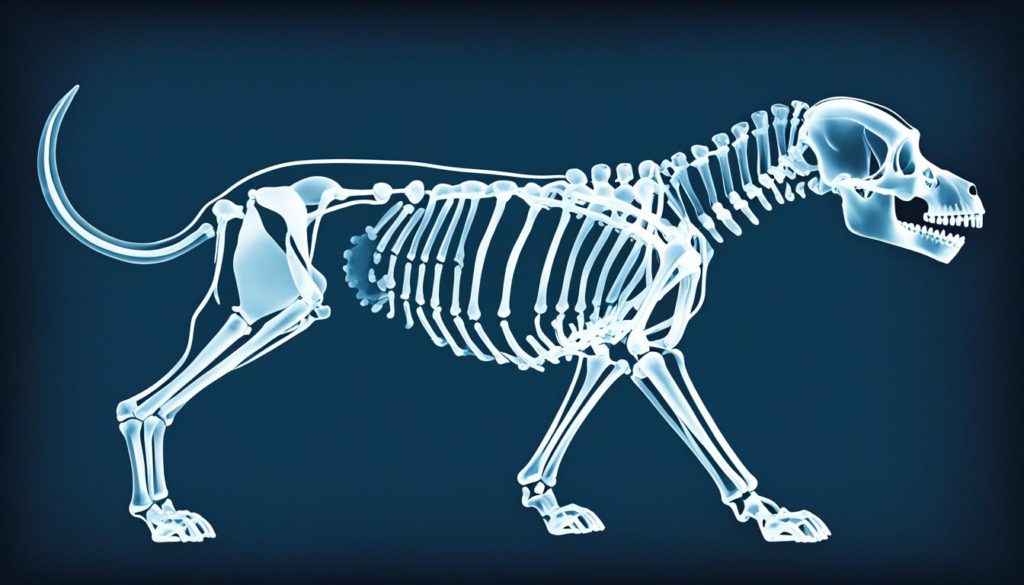The skeletal system of a dog plays a crucial role in providing support, balance, and mobility, just like in humans and other animals. By understanding the anatomy of a dog’s bones, you can better care for your beloved pet and ensure their skeletal health.
The canine skeletal system consists of bones, muscles, cartilages, tendons, ligaments, and connective tissues. Major bone parts in a dog’s anatomy include the scapula, humerus, ulna and radius, metacarpals, femur, patella, tibia and fibula, metatarsals, vertebra, and pelvis. Joints such as the shoulder, elbow, hip, and stifle enable movement and flexibility.
Key Takeaways:
- Dog bones provide support, balance, and mobility.
- Understanding the anatomy of a dog’s bones is essential for better care.
- Major bone parts include scapula, humerus, ulna and radius, femur, and more.
- Joints such as the shoulder, elbow, hip, and stifle enable movement.
- Care for your dog’s skeletal health through regular exercise, proper nutrition, and veterinary check-ups.
Dog Bone Types and Composition
When it comes to dog bones, there is a variety of types and compositions. Understanding these differences can help you choose the best bones for your furry friend. The two main types of bones are cortical bone and cancellous bone.
Cortical bone:
Also known as compact bone, cortical bone is dense and provides strength and support to the skeletal structure of dogs. It forms the outer layer of bones and contributes to their durability and resistance to fracture. This type of bone is essential for supporting your dog’s body weight and facilitating their movements.
Cancellous bone:
Cancellous bone, also referred to as spongy or trabecular bone, has a porous structure. It is found inside the cortical bone and plays a crucial role in providing flexibility to the skeletal system. The porous nature of cancellous bone allows for the absorption of impact and stress, reducing the risk of injuries.
Furthermore, the composition of dog bones consists of key elements. Two significant components are collagen and hydroxyapatite.
Collagen:
Collagen is a protein that gives bones their strength and resilience. It forms a matrix within the bone, providing structure and preventing the bones from becoming brittle. Collagen helps absorb shock and contributes to the overall integrity of the skeletal system.
Hydroxyapatite:
Hydroxyapatite is a mineral that provides hardness to bones. It is primarily composed of calcium and phosphate ions, which form crystals within the collagen matrix. This mineralization process enhances the rigidity of the bones, allowing them to withstand pressure and support the dog’s body.
Bone growth in dogs is a fascinating process called ossification, where cartilage gradually transforms into bone tissue. This process ensures proper bone development and contributes to a dog’s overall skeletal health.
The composition of dog bones includes collagen, a protein that gives bones strength, and hydroxyapatite, a mineral that provides hardness.
Comparison of Dog Bone Types and Composition
| Types of Bone | Composition | Main Function |
|---|---|---|
| Cortical Bone | Dense; composed of collagen and hydroxyapatite | Provides strength and support to skeletal structure |
| Cancellous Bone | Porous; composed of collagen and hydroxyapatite | Provides flexibility and absorbs impact |
Functions of Dog Bones
Dog bones serve various essential functions in a canine’s body. Understanding these functions is crucial for comprehending the significance of maintaining a dog’s skeletal health.
- Support and Structure: Dog bones provide support and structure to the body, ensuring the overall stability of the skeletal system. They form the framework that safeguards vital organs, allowing dogs to move and function effectively.
- Attachment Points: Bones serve as attachment points for muscles, tendons, and ligaments. These structures enable movement by working together, facilitating the dog’s range of motion.
- Blood Cell Production: Within the bone marrow, located in the central cavities of certain bones, blood cells are produced. This vital function contributes to a dog’s overall health and wellbeing.
- Mineral Storage: Dog bones store essential minerals like calcium and phosphorus. These minerals are crucial for maintaining strong and healthy bones.
Despite their critical functions, dog bones are vulnerable to various diseases and conditions that can impair their performance and affect the overall skeletal health of dogs. Common dog bone diseases include fractures, arthritis, and osteoporosis.
| Dog Bone Diseases | Symptoms | Treatment |
|---|---|---|
| Fractures | • Swelling • Intense pain • Visible deformity • Difficulty bearing weight |
• Splinting • Surgery • Medication for pain management |
| Arthritis | • Joint stiffness • Lameness • Difficulty getting up or lying down • Reduced activity levels |
• Weight management • Exercise and physical therapy • Medication for pain relief |
| Osteoporosis | • Fractures occur easily • Weak, brittle bones • Back pain • Loss of height |
• Calcium and vitamin D supplementation • Exercise • Medication to strengthen bones |
Regular veterinary care, a balanced diet, and appropriate exercise can help prevent and manage dog bone diseases, ensuring your canine companion maintains optimal skeletal health.
Growth and Development of Dog Bones
The growth and development of dog bones depend on various factors, including breed, age, and nutrition. During the maturation process, puppy bones transform and reach full maturity, supporting a dog’s physical activity. Smaller toy breeds typically achieve full bone development in around six months, while larger giant breeds can take anywhere from 18 months to two years to reach their full bone growth potential.
To ensure proper bone development during this crucial growth phase, it is essential to provide your dog with appropriate nutrition. A balanced diet that includes adequate amounts of protein, calcium, and other essential nutrients is crucial for healthy dog bone growth. Understanding the skeletal anatomy of dogs can help identify any potential issues and ensure optimal growth and development for your furry companion.

Dog Bone Growth by Breed Size
| Breed Size | Time to Full Bone Maturity |
|---|---|
| Toy Breeds | Around 6 months |
| Small to Medium Breeds | Around 9 to 12 months |
| Large Breeds | Around 12 to 18 months |
| Giant Breeds | Around 18 months to 2 years |
Canine Skeletal System and Overall Health
The canine skeletal system plays a crucial role in a dog’s overall health and well-being. By understanding the importance of maintaining bone health, you can ensure your pet enjoys proper support, mobility, and functionality.
Regular exercise and movement are essential for maintaining optimal bone density and strength in dogs. Physical activity helps stimulate bone remodeling, which is the process of breaking down old bone tissue and replacing it with new, stronger bone. Whether it’s daily walks, playtime at the park, or engaging in specific dog sports, regular exercise can contribute to the long-term skeletal health of your furry friend.
Proper nutrition is another key factor in maintaining a healthy skeletal system. A balanced diet that includes essential nutrients such as protein, calcium, and vitamins is crucial for supporting bone health. Additionally, certain supplements, like glucosamine and chondroitin, can provide added support for your dog’s bones and joints.
Regular veterinary check-ups and screenings are vital for identifying any potential skeletal issues early on. Through physical examinations and diagnostic tests, veterinarians can assess the condition of your dog’s bones and detect any abnormalities or signs of bone diseases. Early detection allows for timely intervention and management, preventing more serious conditions from developing in the future.
Remember, maintaining the health of the canine skeletal system is a proactive approach to ensuring your dog’s overall well-being. By prioritizing exercise, nutrition, and regular veterinary care, you can support your furry companion’s bones, allowing them to live an active and healthy life.

| Bone Health Tips for Dogs |
|---|
| Provide regular exercise and physical activity to maintain bone density and strength. |
| Ensure a balanced diet that includes essential nutrients such as protein and calcium. |
| Consider adding supplements like glucosamine and chondroitin for additional bone support. |
| Schedule regular veterinary check-ups and screenings to monitor your dog’s skeletal health. |
| Speak to your veterinarian about any concerns or questions regarding your dog’s bone health. |
Conclusion
Understanding the anatomy and functions of dog bones is crucial for providing optimal care and support for your furry friend’s skeletal health. By familiarizing yourself with the different types, composition, and growth process of dog bones, you can better identify potential issues and take appropriate steps to prevent or treat bone diseases.
Regular exercise is essential for maintaining your dog’s skeletal system. Engaging in activities like daily walks, running, or playing fetch helps promote bone density and strength. Remember to consider your dog’s age, breed, and overall health when determining the appropriate level of physical activity.
Proper nutrition is equally important for supporting your dog’s skeletal health. Providing a balanced diet rich in protein, vitamins, and minerals, including calcium and phosphorus, is key to optimal bone development and maintenance. Consulting with a veterinarian can help ensure you are feeding your dog the right food and considering any specific dietary needs.
Regular veterinary care plays a crucial role in maintaining your dog’s skeletal system. Routine check-ups, screenings, and preventive measures can help detect any potential skeletal issues early on and prevent them from becoming more serious. A veterinarian can provide personalized advice and recommendations tailored to your furry friend’s specific needs, ensuring their skeletal health remains in top condition.
FAQ
What is the function of the skeletal system in a dog?
The skeletal system in a dog provides support, balance, and mobility. It also protects vital organs and serves as attachment points for muscles, tendons, and ligaments.
What are the different types of bones in a dog’s anatomy?
There are two main types of bones in a dog’s anatomy: cortical bone (compact bone) and cancellous bone (spongy bone).
What is the composition of dog bones?
Dog bones are composed of collagen, a protein that gives them strength, and hydroxyapatite, a mineral that provides hardness.
What are the functions of dog bones?
Dog bones provide support and structure to the body, protect vital organs, enable movement, produce blood cells, and store essential minerals.
How do dog bones grow?
Dog bones grow through a process called ossification, where cartilage is gradually replaced by bone tissue.
How does the growth and development of dog bones vary?
The growth and development of dog bones vary based on factors such as breed, age, and nutrition. Smaller toy breeds reach full maturity in around 6 months, while larger giant breeds take 18 months to 2 years.
How can I maintain the health of my dog’s skeletal system?
Regular exercise, proper nutrition, and regular veterinary check-ups are essential for maintaining the health of your dog’s skeletal system. Exercise helps maintain bone density and strength, while a balanced diet supports bone health. Regular check-ups can help identify potential skeletal issues early on.
Why is it important to understand the anatomy and functions of dog bones?
Understanding the anatomy and functions of dog bones is crucial for providing optimal care and support for your dog’s skeletal health. It helps in identifying potential issues and taking appropriate steps to prevent or treat bone diseases.
